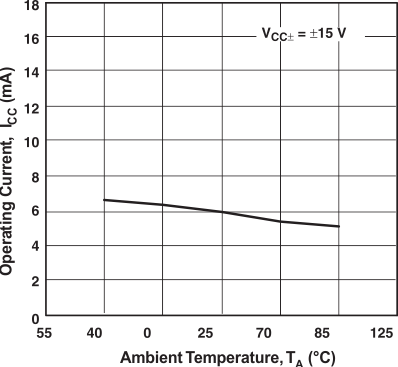JAJSVL8E April 2003 – November 2024 RC4580
PRODUCTION DATA
- 1
- 1 特長
- 2 アプリケーション
- 3 概要
- 4 Pin Configuration and Functions
- 5 Specifications
- 6 Detailed Description
- 7 Application and Implementation
- 8 Device and Documentation Support
- 9 Revision History
- 10Mechanical, Packaging, and Orderable Information
パッケージ・オプション
デバイスごとのパッケージ図は、PDF版データシートをご参照ください。
メカニカル・データ(パッケージ|ピン)
- D|8
- P|8
- DDF|8
- DGK|8
- PW|8
サーマルパッド・メカニカル・データ
発注情報
5.7 Typical Characteristics
 Figure 5-1 Maximum Output Voltage Swing vs Load Resistance
Figure 5-1 Maximum Output Voltage Swing vs Load Resistance Figure 5-3 Output Voltage Swing vs Output Current
Figure 5-3 Output Voltage Swing vs Output Current Figure 5-5 Operating Current vs Temperature
Figure 5-5 Operating Current vs Temperature Figure 5-7 Input Offset Voltage vs Temperature
Figure 5-7 Input Offset Voltage vs Temperature Figure 5-9 Maximum Output Voltage Swing vs Operating Voltage
Figure 5-9 Maximum Output Voltage Swing vs Operating Voltage Figure 5-11 Total Harmonic Distortion vs Output Voltage
Figure 5-11 Total Harmonic Distortion vs Output Voltage Figure 5-2 Maximum Ouput Voltage Swing vs Frequency
Figure 5-2 Maximum Ouput Voltage Swing vs Frequency Figure 5-4 Equivalent Input Noise Voltage vs Frequency
Figure 5-4 Equivalent Input Noise Voltage vs Frequency Figure 5-6 Output Voltage Swing vs Temperature
Figure 5-6 Output Voltage Swing vs Temperature Figure 5-8 Input Bias Current vs Temperature
Figure 5-8 Input Bias Current vs Temperature Figure 5-10 Operating Current vs Operating Voltage
Figure 5-10 Operating Current vs Operating Voltage Figure 5-12 Voltage Gain, Phase vs Frequency
Figure 5-12 Voltage Gain, Phase vs Frequency